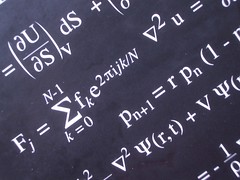 |
I have already spoken about Jacobi algebroids and quasi Q-manifolds in earliear posts here and here. Details can be found in [1].
|
In the paper [1] I show that a Jacobi algebroid, which is nothing more than a linear odd Jacobi bracket on a vector bundle, is equivalent to a weight one quasi Q-manifold structure.
A little more specifically, consider the supermanifold \(\Pi E \) build from a vector bundle \(E \rightarrow M\). The supermanifold \(\Pi E \) is equipped with natural coordinates \((x^{A}, \xi^{\alpha})\). Recall that \(\Pi\) is the parity reversion functor and that it shits the parity of the fibre coordinates. So, is we have fibre coordinate \((y^{\alpha})\) on \(E\) of parity \(\widetilde{y^{\alpha}} =\widetilde{\alpha}\), then \(\widetilde{\xi^{\alpha}}= \widetilde{\alpha}+1 \). The weight is assigned naturally as zero to the base coordinates and one to the fibre coordinates. The parity reversion functor does not act on the weights.
A Jacobi algebroid is then in one-to-one equivalence with an odd vector field on \(\Pi E\)
\(D = \xi^{\alpha}Q_{\alpha}^{A}(x) \frac{\partial}{\partial x^{A}} + \frac{1}{2} \xi^{\alpha}\xi^{\beta}Q_{\beta \alpha}^{\gamma}(x) \frac{\partial}{\partial \xi^{\gamma}}\),
and an odd function also on \(\Pi E\)
\(q = \xi^{\alpha}Q_{\alpha}(x)\),
both of weight one and satisfy
\(\left[D,D\right] = 2 q D\) and \(D(q)=0\).
A supermanifold with such a structure I call a quasi Q-manifold.
Back to Lie algebroids
There is a well established one-to-one correspondence between Jacobi algebroids and Lie algebroids in the presence of a one cocycle [2,3]. A Lie algerbroid in the presence of a one cocycle is understood as a \((\Pi E, Q, \phi)\), where \(Q\) is a homological vector field of weight one and \(\phi \) is a weight one (linear) function on \(\Pi E\). Now as we are in the category of supermanifold, we need to insist that the weight one function is odd. The structures here satisfy
\(Q^{2}=0\) and \(Q(\phi) =0\).
Now, given the initial data of a weight one quasi Q-manifold that encodes the Jacobi algebroid we can pass directly to a Lie algebroid in the presence of an odd one cocyle viz
\(Q = D {-} q \Delta\)
and set
\(\phi = q\),
where \(\Delta\) is the Euler vector field, which in local coordinates looks like
\(\Delta = \xi^{\alpha} \frac{\partial}{\partial \xi^{\alpha}}\).
So, now what about the bracket on sections of this Lie algebroid and the anchor?
By thinking of the sections of our vector bundle \(E\rightarrow M\) as weight minus one vector fields on \(\Pi E\), we can use the derived bracket formalism. In particular
\(u = u^{\alpha}(x)s_{\alpha} \longrightarrow i_{u} = (-1)^{\widetilde{u}}u^{\alpha}(x)\frac{\partial}{\partial \xi^{\alpha}}\)
provides us with the appropriate identification. Then
\(a(u)(f) := \left[\left[Q, i_{u}\right],f \right] = [[D, i_{u}],f]\)
and
\(i_{[u,v]} := (-1)^{\widetilde{u}}[[Q, i_{u}], i_{v}] =(-1)^{\widetilde{u}} [[D,i_{u}], i_{v}] + i_{u}(q) i_{v} – (-1)^{\widetilde{u} \widetilde{v}}i_{v}(q)i_{u}\),
where \(u,v \in \Gamma(E)\) and \(f \in C^{\infty}(M)\).
The interested reader can now work out all the local expressions if they want, it is not hard to do so.
The final remark must be that similar formula appear in the existing literature on Jacobi algebroids for the Lie bracket. This I may try to unravel at some point.
References
[1]Andrew James Bruce, Odd Jacobi manifolds: general theory and applications to generalised Lie algebroids, Extracta Math. 27(1) (2012), 91-123.
[2]J. Grabowski and G. Marmo, Jacobi structures revisited, J. Phys. A: Math. Gen., 34:10975–10990, 2001.
[3]D. Iglesias and J.C. Marrero. Generalized Lie bialgebroids and Jacobi structures, J. Geom. and Phys., 40, 176–199, 2001.

